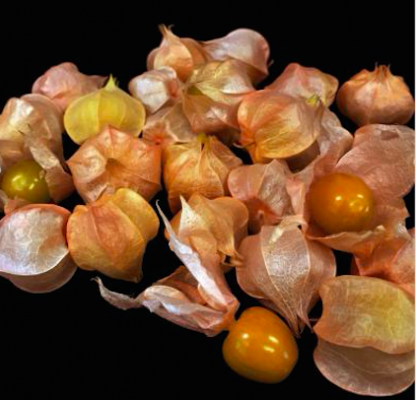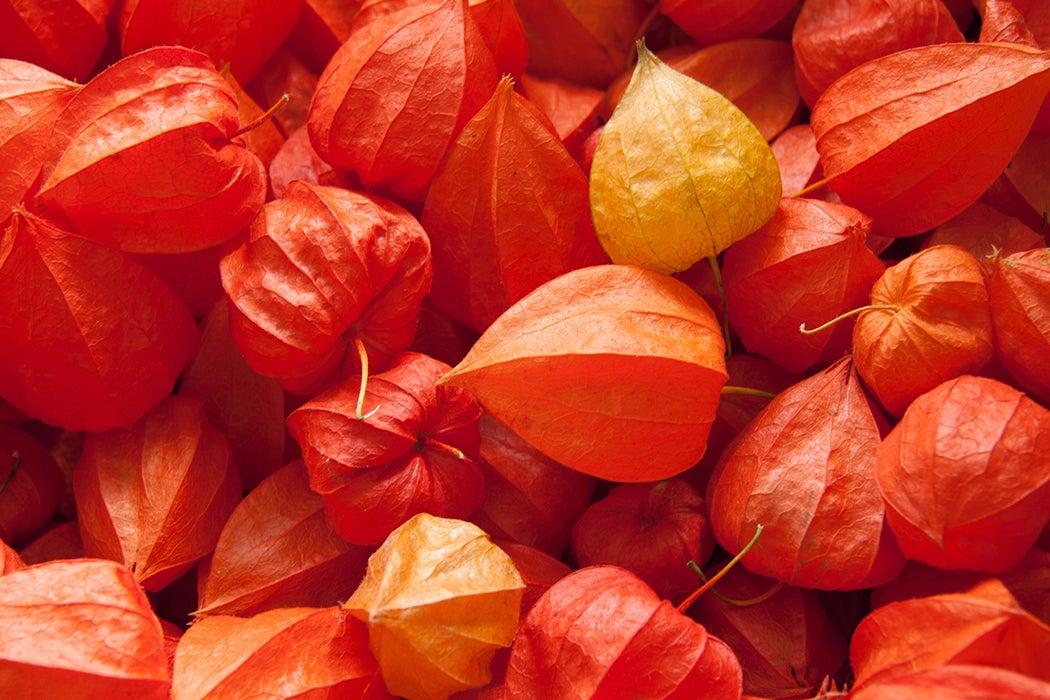Groundcherries, anyone?
You may have never heard of a groundcherry, but you’ve likely seen one—in a Thanksgiving centerpiece, perhaps. An attractive eye-catcher, this plant develops bright orange papery husks, inside which hide small, round fruit of the same color. Commonly known as Chinese Lanterns and scientifically as Physalis pruinosa, the plant has been used more often in fall decorations than in the kitchen, despite the fact that it’s loaded with vitamins C and B, beta-carotene, and antioxidants, and has proven anti-inflammatory properties. It’s edible with a pleasant taste sometimes described as sweet and sour with hints of vanilla, but you’ll hardly find it mentioned in cookbooks, despite the fact that it was featured in a Martha Stewart recipe.
There’s a reason for that. P. pruinosa—which is native to Central and South America, and has a bunch of other names, including husk cherries, strawberry tomatoes, and tomatillo because the berries look like little tomatoes—belongs to the list of the so-called orphan crops. Usually grown locally or regionally, these plants aren’t grown as mainstream agriculture crops because they either don’t produce enough yield, don’t transport well, or don’t last long while ripened and thus have a short shelf life. Groundcherries, for instance, produce few flowers and small fruit. They also often drop their not fully ripened fruit to the ground, which complicates harvesting and may also damage the berries or contaminate them with soil pathogens.
But now Zachary Lippman at Howard Hughes Medical Institute and Joyce Van Eck at the Boyce Thompson Institute think they can improve some of the plant’s limitations. They think that with CRISPR gene editing techniques, it is possible to improve the flowering and fruit size, and make the plant grow in a more compact, less “weedy” fashion. So far, the team has sequenced a sampling of the groundcherry’s genome, utilized CRISPR techniques to modify the plant, and identified the genes responsible for the groundcherry’s unwanted traits.

Drawing on knowledge from their prior work improving yield in tomatoes, the researchers are hoping to achieve similar breakthroughs in groundcherries. For example, a specific mutation in tomato plants could help with gene-editing necessary to create groundcherries that don’t drop fruit to the ground. “It’s exciting that we can take what we have learned [about] tomatoes and apply it to distantly related species,” says Van Eck.
Scientists are always on the lookout for the next orphan crop that has the potential to “outgrow” its original geographic realm and feed the world’s expanding population.
That’s how quinoa, an Andean grain once favored by indigenous people of South America and later snubbed by the Spaniards as the poor Indians’ food,” has recently risen to international stardom for its gamut of health benefits. But there are other reasons why studying orphan crops is important. Mankind greatly depends on a limited crop list, such as rice, wheat, corn, soybeans, or potatoes for sustaining the global food systems. Having been cultivated for centuries, these staple crops have certain genetic vulnerability to environmental stressors. At the same time, wild plants have attractive and important genetic features, such as disease-resistance, or ability to tolerate droughts, floods and increased soil salinity. Genetic info from these wild plants helps scientists to cultivate other crops that withstand weather flukes.
Lippman’s and Van Eck’s study is the first step to growing groundcherries for commercial consumption, but researchers find it promising. “I firmly believe that with the right approach, the groundcherry could become a major berry crop,” Lippman says.







